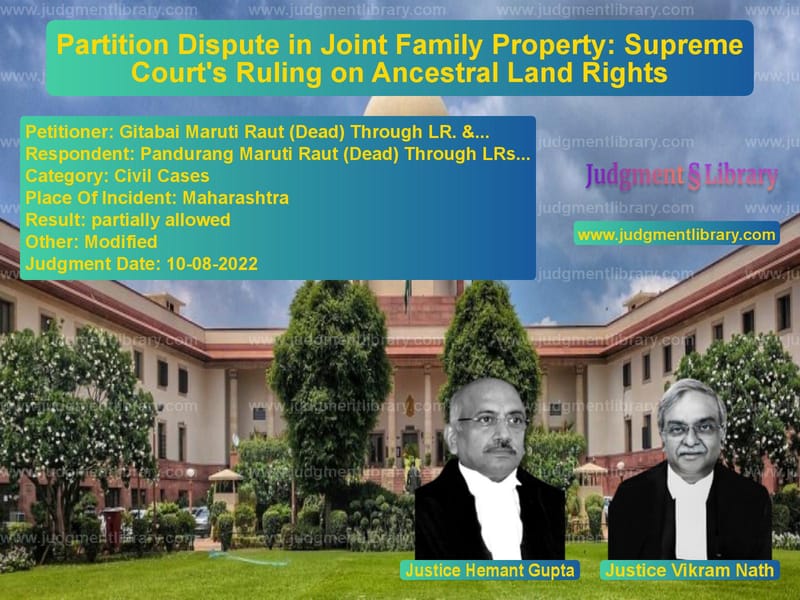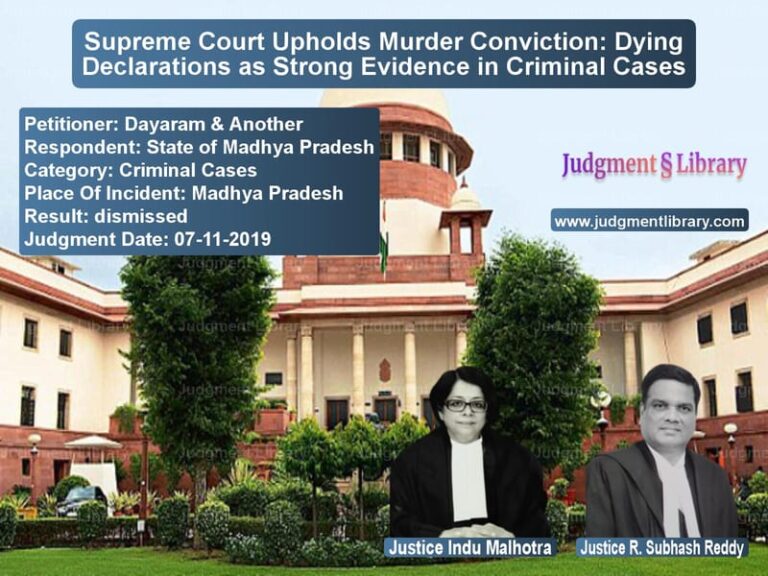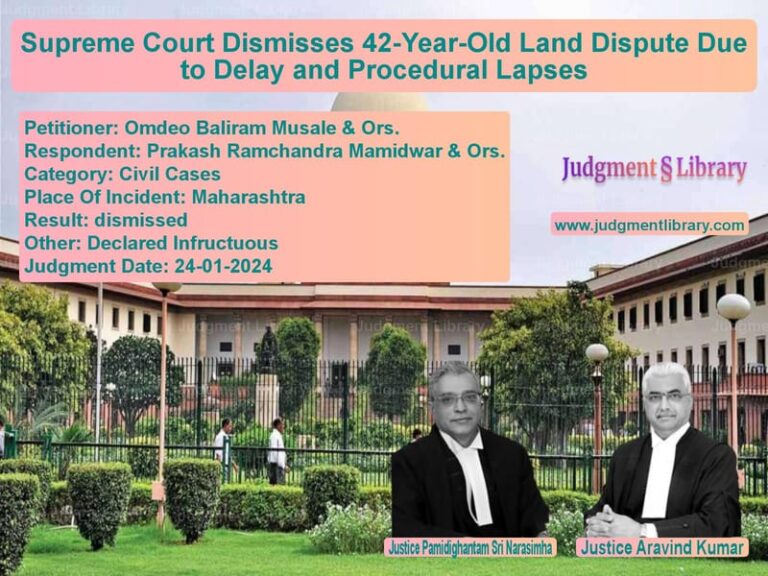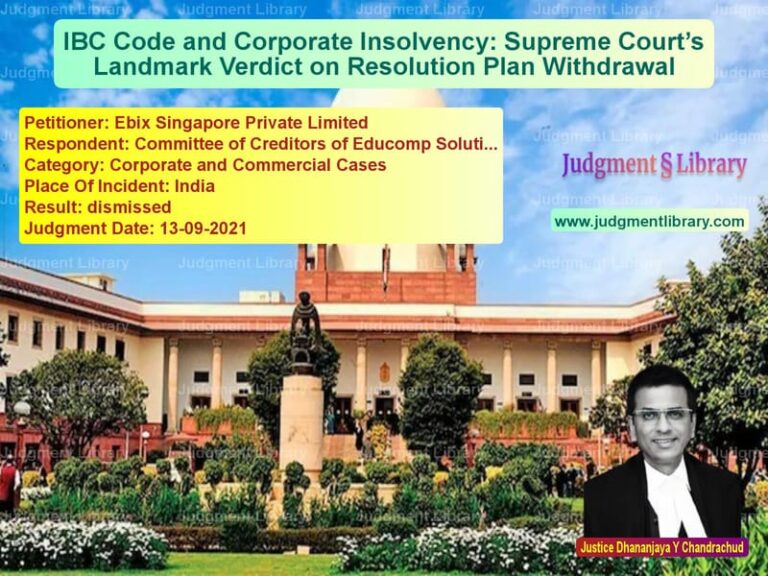Partition Dispute in Joint Family Property: Supreme Court’s Ruling on Ancestral Land Rights
The case of Gitabai Maruti Raut (Dead) Through LR. & Ors. vs. Pandurang Maruti Raut (Dead) Through LRs. & Ors. revolves around a partition dispute concerning ancestral property in the villages of Pirangut and Nande. The Supreme Court’s ruling clarifies the legal principles governing joint family property and the rights of legal heirs.
Background of the Case
The dispute originated from a claim that the properties at villages Pirangut and Nande were joint family ancestral properties in the hands of Maruti, the deceased son of Balaji. The family tree established that Balaji was the common ancestor who left behind four sons—Narayan, Raghunath, Maruti, and Sopan.
Maruti passed away in 1966 and was married twice. His second wife, Geetabai (the original plaintiff), filed a suit for partition, claiming a share in the properties. However, Geetabai died during the proceedings, and her legal heirs continued the litigation.
Legal Questions Before the Court
The Supreme Court was called upon to decide:
- Whether the properties at Pirangut and Nande were joint family ancestral properties.
- Whether the plaintiff and other legal heirs had a rightful claim to these properties.
Arguments Presented
Petitioners’ (Appellants’) Arguments
- The land at Pirangut was purchased using ancestral funds and, therefore, constituted joint family property.
- Despite claims that the property was in the name of Raghunath, it had been partitioned among the four brothers in 1961.
- A memorandum of settlement (Ex-111) clearly demonstrated that the property was jointly held and had been divided among the family members.
- The revenue records (Mutation Entry No. 1274) confirmed the partition.
Respondents’ Arguments
- The property at Nande was purchased by Defendant No. 1 (Pandurang) after Maruti’s death in 1969, meaning it could not be considered joint family property.
- There was no evidence proving that the land at Nande was bought using income from joint family funds.
- The High Court had correctly concluded that the land at Pirangut was acquired independently and did not form part of the joint family estate.
- The claim regarding the ancestral nature of the properties was unsupported by documentary evidence.
Supreme Court’s Observations
On the Property at Nande
The Supreme Court upheld the High Court’s finding that:
“The appellant neither pleaded nor proved that there is sufficient nucleus of the income from the joint family from which the property at village Nande could be purchased.”
Since no evidence was presented to establish the ancestral nature of the Nande property, the Court ruled against the appellants on this issue.
On the Property at Pirangut
The Supreme Court found that the High Court had misread the evidence. It observed:
“The land at Pirangut was ancestral land. The Mutation Entry No. 1274 itself shows that the land was partitioned amongst the brothers. It was not a gift by Raghunath to Pandurang.”
The Court also noted that:
“The name of Pandurang in respect of Maruti’s share was recorded only after Maruti’s death, indicating that the property was part of the joint family estate.”
On the Memorandum of Settlement
The Court emphasized the significance of the memorandum of settlement dated 23.12.1961 (Ex-111), which showed that the Pirangut land was divided among the four brothers.
“The evidence on record, including written memorandum of settlement and the mutation entry, shows that Pirangut was a joint family property, and the term ‘partition’ was used.”
Judgment and Its Implications
The Supreme Court modified the High Court’s decision:
- The land at Nande was not joint family property and remained with Defendant No. 1.
- The land at Pirangut was ruled as joint family property, and all legal heirs, including Geetabai’s heirs, were entitled to a share.
- A preliminary decree was passed, directing the parties to seek a final decree from the competent court.
Significance of the Judgment
- Clarifies Joint Family Property Rights: The ruling reinforces that property acquired using ancestral funds remains joint family property unless proven otherwise.
- Importance of Documentary Evidence: The judgment highlights the role of mutation entries and settlement documents in determining ancestral property claims.
- Equitable Distribution: The ruling ensures that all legal heirs receive their rightful share in joint family property.
Conclusion
The Supreme Court’s decision in Gitabai Maruti Raut vs. Pandurang Maruti Raut establishes a vital precedent in property law. It underscores the need for concrete evidence when claiming ancestral rights and protects the interests of legal heirs in joint family estates.
Petitioner Name: Gitabai Maruti Raut (Dead) Through LR. & Ors..Respondent Name: Pandurang Maruti Raut (Dead) Through LRs. & Ors..Judgment By: Justice Hemant Gupta, Justice Vikram Nath.Place Of Incident: Maharashtra.Judgment Date: 10-08-2022.
Don’t miss out on the full details! Download the complete judgment in PDF format below and gain valuable insights instantly!
Download Judgment: gitabai-maruti-raut-vs-pandurang-maruti-rau-supreme-court-of-india-judgment-dated-10-08-2022.pdf
Directly Download Judgment: Directly download this Judgment
See all petitions in Property Disputes
See all petitions in Succession and Wills
See all petitions in Landlord-Tenant Disputes
See all petitions in Judgment by Hemant Gupta
See all petitions in Judgment by Vikram Nath
See all petitions in partially allowed
See all petitions in Modified
See all petitions in supreme court of India judgments August 2022
See all petitions in 2022 judgments
See all posts in Civil Cases Category
See all allowed petitions in Civil Cases Category
See all Dismissed petitions in Civil Cases Category
See all partially allowed petitions in Civil Cases Category







